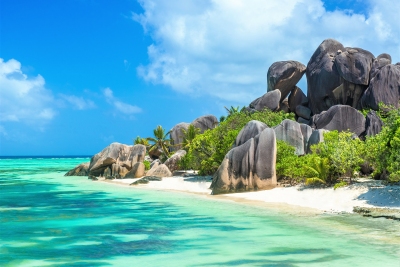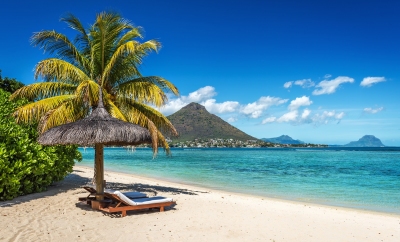
The Seychelles archipelago is one of the most exotic and beautiful destinations on earth. You regularly see the beautiful white beaches, the palm trees in the background and the blue sea as a location in commercials. The archipelago also offers many opportunities for excursions into the primeval forests of the islands and is home to several rare animal and plant species.
The Seychelles are located not far from the East African coast in the Indian Ocean. The capital of the former French colony is Victoria. Most people here speak Seychelles Creole, but the official languages include English and French.
Below we present the most exciting tours, the most beautiful attractions and the best sights in the Seychelles.
1. Victoria: Capital of the island state
Victoria is the capital of the Seychelles and the first destination for many travellers. Even though Victoria is called the smallest capital of the world – after all, only 26,000 inhabitants live in Victoria – there are still some sights to discover here. One of the first places to go is the Victoria market, which is only open until 12 noon.
In addition to the many small shops, Victoria also has the Hindu temple Arul Mihu Navasakthi, the cathedral of Victoria and the Clock Tower. It is also worth tasting Creole cuisine in one of the many restaurants, especially for fish lovers. The local cuisine is a mix of Asian, Indian, South African and European dishes. A special feature is, for example, the octopus curry.
2. Anse Source d’Argent
Anse Source d’Argent on the island of La Digue is one of the most popular and most visited beaches in the Seychelles. The reason for this should become immediately apparent to every visitor: white sandy beach meets turquoise blue, shallow water and in the background the grey granite rocks rise. This beach has often been used for filming and advertising in the past.
Perhaps it is the most famous beach in the world. Anse Source d’Argent is protected from the flood by an offshore reef, the water here is mostly calm and therefore very family friendly. The beach is also perfect for snorkelling. It can be easily reached via the L’Union Estate park, which is signposted.
3. St. Anne Marine National Park
St. Anne Marine National Park is located between the islands of St. Anne, Cerf, Long, Round and Moyenne. In 1973, the marine area was placed under conservation, making it the first marine reserve in the Indian Ocean. The exploration of the underwater world is worthwhile especially in the months of the northwest monsoon, thus from October to April. Since fishing has not been allowed here since the area was declared a nature reserve, the diversity of species and the quantity of marine animals is impressively high.
About 150 species of fish and other marine animals live in the snorkeling areas of the St. Anne Channel. The entrance fee is also used to finance the nature reserve. The park includes not only the coral reef and the underwater world, but also the surrounding islands. On the hiking trails you can admire a rich flora and fauna.
4. Curieuse Island
Curieuse Island is home to several natural attractions and is one of the most remote and natural islands in the Seychelles. It used to be called Ăle Rouge, the “Red Island”. It received its present name from the French explorer Marion Dufresne, who named it after his ship in 1768. What makes the island so special are its natural treasures.
Here you will find the Coco de Mer, the largest coconut in the world. The Coco de Mer can weigh up to 20 kg. In addition, a large number of mangroves can be explored here, in which one can find one of the giant tortoises with a little luck. There is also a breeding station for the animals on the island. The rare hawksbill turtle is also native to Curieuse.
5. Morne Blanc
The Morne Blanc Island should be of special interest for hiking fans. The destination of a Morne Blanc tour is the 905 meter high summit of the island. On the way to the summit several tea plantations and tropical forests are crossed. Lichens, mosses, ferns and dense undergrowth line the trail up to one of the best vantage points in the Seychelles.
For the successful hiker there is a spectacular panoramic view up here. The Morne Blanc is home to many bird species and also the smallest frog in the world. Due to his size of only 1 cm this might be very difficult, but it is very likely that you will hear him at least. The Sooglossus gardineri is surprisingly loud for its size.
6. Vallée de May
VallĂ©e de Mai is another national park, this time on the island Praslin. The German name is also Maital. VallĂ©e de Mai was declared a UNESCO World Heritage Site in 1983. The VallĂ©e is a valley and, at 19.5 hectares, the world’s smallest natural heritage site. At the same time, the forest is the largest intact forest in which the Coco de Mer grows. The special thing about the forest is that it already existed when the Seychelles still belonged to the primeval continent of Gondwana.
So when the archipelago was connected with Africa, South America, Australia, India, Madagascar and New Guinea millions of years ago. Well maintained paths lead through the jungle and let you explore the exotic fauna and flora. The Vallée is home to the Seychelles Black Parrot, Praslin Snail, Seychelles Tree Frog and Green Day Gecko.
7. Island Silhouette
The mountainous island of Silhouette is located about 20 km from the northwest coast of Mahés. The mountains on the island are 751 meters high, the island forms the third largest island of the Seychelles. At the same time, Silhouette is hardly inhabited by humans, making it the ideal destination for nature-loving hikers.
The low building density is due, among other things, to the steep rock faces and the hard to reach coast. A few accommodations and hiking trails, there is no more civilization on the island. The Anse La Passe beach on the island is sheltered by a reef and its bright blue waters invite you to swim and snorkel.
8. Bird Island
Bird Island is probably one of the smaller sights among the Seychelles. The northeasternmost island, 100 km from Mahé, with a length of 1500 metres and a width of 800 metres, has manageable dimensions. The small island is primarily home to millions of seabirds, especially the Sooty Tern.
The island serves as its breeding ground every year. Particularly in the period from April to October, the visitor is offered a real spectacle, in which not only die-hard bird lovers get into raptures. Also apart from the incubation, numerous bird-types can be observed on Bird Island.
9. Anse Lazio
Anse Lazio is considered one of the most beautiful beaches in the world, of which there are certainly many in the Seychelles. The white sand, the clear blue water and the white granite rocks make for uniquely beautiful holiday photos. The Anse Lazio lies on Praslin and is one of the absolute sights of the island.
The beach is easy to reach by car, parking is nearby and there is also a bus stop. The Anse Lazio is one of the beaches that have been developed for tourism, which is why it is always well visited. For your own well-being there are several restaurants and a bar.
10. Beau Vallon on Mahé
Most of the dream beaches in the Seychelles are actually deserted even in the high season. Due to the small number of visitors and the very sustainable tourism approach, everyone will find their own personal piece of paradise on the enchanting islands.
But you have to share your luck at the Beau Vallon on Mahé, probably the most popular and busiest beach of the Seychelles. Nevertheless, the bay is one of the most beautiful sightseeings for us, as nowhere else you can experience the casual beach life of the locals up close, enjoy fresh coconuts at sunset or treat yourself to a freshly grilled tuna steak from one of the stalls for lunch.
More things to do and activities for your Seychelles holiday
Best time to visit Seychelles
We recommend the following months as best time to travel for exploring the attractions and acivities of Seychelles:
March, April, May, June, July, August, and September
You can find more information about the weather, including all climate data, on our climate page for Seychelles.


![Anse Takamaka, Mahé, Seychelles (Jean-Marie Hullot) [flickr.com] CC BY
License Information available under 'Proof of Image Sources'](/wp-content/uploads/reiseziele/anse-takamaka-mah-seychelles6453_preview.jpg)
![Grande Soeur, a small island near La Digue, Seychelles (Jean-Marie Hullot) [flickr.com] CC BY
License Information available under 'Proof of Image Sources'](/wp-content/uploads/reiseziele/grande-soeur-a-small-island--near-la-digue-seychelles1899_preview.jpg)




